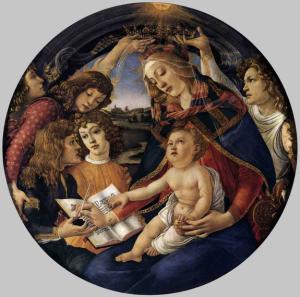
The Canticle of Mary, also called The Magnificat, appears below both in English and in Latin.

Glory be to the Father and to the Son and to the Holy Spirit.
As it was in the beginning, is now and ever shall be, world without end. Amen
Ecce enim ex hoc beátam
me dicent omnes generatiónes,
quia fecit mihi magna,
qui potens est,
et sanctum nomen eius,
et misericórdia eius in progénies
et progénies timéntibus eum.
Fecit poténtiam in bráchio suo,
dispérsit supérbos mente cordis sui;
depósuit poténtes de sede
et exaltávit húmiles.
Esuriéntes implévit bonis
et dívites dimísit inánes.
Suscépit Ísrael púerum suum,
recordátus misericórdiæ,
sicut locútus est ad patres nostros,
Ábraham et sémini eius in sæcula.
Glória Patri et Fílio
et Spirítui Sancto.
Sicut erat in princípio,
et nunc et semper,
et in sæcula sæculórum.
Amen.
Scripture text: Revised Standard Version - Catholic Edition
The Magnificat [Latin: magnifies], also called The Canticle of Mary, is recorded in the Gospel of Luke (1:46-55). It is the Virgin Mary's joyous prayer in response to her cousin Elizabeth's greeting (Luke 1: 41-45). This great hymn forms part of the Church's prayer in the Divine Office (Liturgy of the Hours). When it is recited as part of the Divine Office, it is followed by the Gloria Patri ("Glory be"). The traditional sung Magnificat is Latin plainchant. One of the hymn's most glorious musical renditions is the version of the Magnificat by J.S. Bach.
The Catechism of the Catholic Church describes the Magnificat as "the song both of the Mother of God and of the Church" [CCC 2619], and explains this prayer's significance:
Mary's prayer is revealed to us at the dawning of the fullness of time. Before the Incarnation of the Son of God, and before the outpouring of the Holy Spirit, her prayer cooperates in a unique way with the Father's plan of loving kindness: at the Annunciation, for Christ's conception; at Pentecost, for the formation of the Church, His Body. In the faith of His humble handmaid, the Gift of God found the acceptance He had awaited from the beginning of time. She whom the Almighty made "full of grace" responds by offering her whole being: "Behold I am the handmaid of the Lord; let it be [done] to me according to Thy word". "Fiat": this is Christian prayer: to be wholly Gods' because He is wholly ours. [CCC 2617]
The above is taken from: http://www.wf-f.org/Magnifi.html
The icon is The Madonna of The Magnificat, 1480-81, by Sandro Botticelli

This site is sponsored by The Missionary Servants of the Most Holy Trinity
For information on becoming a Catholic Religious Missionary contact:
www.MissionaryServantVocations.org
Michael Einarsen
Assistant Director of Vocations
Tel: 464-206-2765
Email: USAVocations@TrinityMissions.org
_